Analysis of Geologic CO2 Migration Pathways in Farnsworth Field, NW Anadarko Basin
Abstract
:1. Introduction
2. Anadarko Basin Overview
3. Subsurface Structure of the Western Anadarko Basin
3.1. Interpretation of 2D Seismic Lines
3.2. Interpretation of 3D Seismic Survey
4. Flow Paths in the CO2 Reservoir
4.1. Tracer Study Setup
4.2. Tracer Study Results
4.2.1. Tracer Tests of WAG Injection Wells 13-13, 13-10A, and 13-5
4.2.2. Tracer Test of Water-Injection Well 14-1
4.2.3. Tracer Test of WAG Injection Well 13-3
4.3. Discussion: Interpretation of Tracer Study Results
5. Petroleum System Model of the Farnsworth Petroleum Field
5.1. Setup of 1D Petroleum System Models
5.2. Results of 1D Petroleum System Modeling
5.3. 2D Petroleum System Modeling Setup
5.4. Results of 2D Petroleum System Modeling
6. Conclusions
Author Contributions
Funding
Acknowledgments
Conflicts of Interest
References
- Bachu, S. Sequestration of CO2 in geological media: Criteria and approach for site selection in response to climate change. Energy Convers. Manag. 2000, 41, 953–970. [Google Scholar] [CrossRef]
- Holloway, S. Storage of fossil fuel-derived carbon dioxide beneath the surface of the Earth. Annu. Rev. Energy Environ. 2001, 26, 145–166. [Google Scholar] [CrossRef]
- Lackner, K.S. A guide to CO2 sequestration. Science 2003, 300, 1677–1678. [Google Scholar] [CrossRef] [PubMed]
- Morgan, A.; Grigg, R.; Ampomah, W. A gate-to-gate life cycle assessment for the CO2-EOR operations at Farnsworth Unit (FWU). Energies 2021, 14, 2499. [Google Scholar] [CrossRef]
- Bachu, S.; Gunter, W.D.; Perkins, E.H. Aquifer disposal of CO2: Hydrodynamic and mineral trapping. Energy Convers. Manag. 1994, 35, 269–279. [Google Scholar] [CrossRef]
- Davis, H.G.; Northcutt, R.A. The greater Anadarko Basin: An overview of petroleum exploration and development. In Anadarko Basin Symposium; Johnson, K.S., Ed.; 1988; Volume 90, pp. 13–24. [Google Scholar]
- Metz, B.; Davidson, O.; De Coninck, H.; Loos, M.; Meyer, L. IPCC Special Report on Carbon Dioxide Capture and Storage: Prepared by Working Group III of the Intergovernmental Panel on Climate Change; Cambridge University Press: Cambridge, NY, USA, 2005. [Google Scholar]
- Scherer, G.W.; Celia, M.A.; Prevost, J.H.; Bachu, S.; Bruant, R.G.; Duguid, A.; Fuller, R.; Gasda, S.E.; Radonjic, M.; Vichit-Vadakan, W. Leakage of CO2 through abandoned wells: Role of corrosion of cement. In Carbon Dioxide Capture for Storage in Deep Geologic Formations; Elsevier: Amsterdam, The Netherlands, 2005; pp. 827–848. [Google Scholar]
- Carey, J.W.; Wigand, M.; Chipera, S.J.; WoldeGabriel, G.; Pawar, R.; Lichtner, P.C.; Wehner, S.C.; Raines, M.A.; Guthrie, G.D. Analysis and performance of oil well cement with 30 years of CO2 exposure from the SACROC Unit, West Texas, USA. Int. J. Greenh. Gas Control 2007, 1, 75–85. [Google Scholar] [CrossRef]
- Carey, J.W.; Svec, R.; Griff, R.; Lichtner, P.C.; Zhang, J.; Crow, W. Wellbore integrity and CO2-brine flow along the casing-cement microannulus. Energy Procedia 2009, 1, 3609–3615. [Google Scholar] [CrossRef] [Green Version]
- Sminchack, J.; Gupta, N.; Byrer, C.; Bergman, P. Issues Related to Seismic Activity Induced by the Injection of CO2 in Deep Saline Aquifers (No. DOE/NETL-2001/1144); National Energy Technology Laboratory: Pittsburgh, PA, USA; Morgantown, WV, USA, 2001. [Google Scholar]
- Streit, J.E.; Watson, M.N. Estimating rates of potential CO2 loss from geological storage sites for risk and uncertainty analysis. Greenh. Gas Control Technol. 2005, 7, 1309–1314. [Google Scholar]
- Cartwright, J.; Huuse, M.; Aplin, A. Seal bypass systems. AAPG Bull. 2007, 91, 1141–1166. [Google Scholar] [CrossRef]
- Chadwick, R.A.; Williams, G.A.; Noy, D.J. CO2 storage: Setting a simple bound on potential leakage through the overburden in the North Sea Basin. Energy Procedia 2017, 114, 4411–4423. [Google Scholar] [CrossRef]
- Parker, R.L. Farnsworth Morrow Oil Field. Panhand. Geonews 1956, 4, 5–12. [Google Scholar]
- Higley, D.K. 4D petroleum system model of the Mississippian system in the Anadarko Basin Province, Oklahoma, Kansas, Texas, and Colorado, U.S.A. Mt. Geol. 2013, 50, 81–98. [Google Scholar]
- Perry, W.J., Jr. Tectonic Evolution of the Anadarko Basin Region, Oklahoma; US Geological Survey: Reston, VA, USA, 1989; p. 19. [Google Scholar]
- Johnson, K.S. (Ed.) Geological evolution of the Anadarko basin. In Anadarko Basin Symposium, Oklahoma Geological Survey Circular; Johnson, K.S. (Ed.) Oklahoma Geological Survey : Toulsa, OK, USA, 1988; Volume 90, pp. 3–12. [Google Scholar]
- Eddleman, M.W. Tectonics and geologic history of the Texas and Oklahoma Panhandles. In Oil and Gas Fields of the Texas and Oklahoma Panhandles; Panhandle (Texas) Geological Society: Amarillo, TX, USA, 1961; pp. 61–68. [Google Scholar] [CrossRef]
- Ham, W.E.; Denison, R.E.; Merritt, C.A. Basement rocks and structural evolution of southern Oklahoma. Okla. Geol. Surv. Bull. 1964, 95, 302. [Google Scholar]
- Forgotson, J.M.; Statler, A.T.; David, M. Influence of regional tectonics and local structure on deposition of Morrow Formation in western Anadarko Basin. AAPG Bull. 1966, 50, 518–532. [Google Scholar]
- Evans, J.L. Major structural and stratigraphic features of the Anadarko Basin. In Pennsylvanian Sandstones of the Mid-Continent; Hyne, N.J., Ed.; Tulsa Geological Society: Tulsa, OK, USA, 1979; Volume 1, pp. 97–113. [Google Scholar]
- Brewer, J.A.; Good, R.; Oliver, J.E.; Brown, L.D.; Kaufman, S. COCORP profiling across the Southern Oklahoma aulacogen: Overthrusting of the Wichita Mountains and compression within the Anadarko Basin. Geology 1983, 11, 109–114. [Google Scholar] [CrossRef]
- Ball, M.M.; Henry, M.E.; Frezon, S.E. Petroleum Geology of the Anadarko Basin Region, Province (115), Kansas, Oklahoma, and Texas; U.S. Geological Survey Open-File Report; U.S. Geological Survey: Reston, VA, USA, 1991.
- Keller, G.R.; Stephenson, R.A.; Hatcher, R.D.; Carlson, M.P.; McBride, J.H. The southern Oklahoma and Dniepr-Donets aulacogens: A comparative analysis. Mem.-Geol. Soc. Am. 2007, 200, 127. [Google Scholar]
- Tave, M.; Gurrola, H. Lithospheric structure of the Southern Oklahoma Aulacogen and surrounding region as determined from broadband seismology and gravity. Geol. Soc. Am. 2013, 45, 4. [Google Scholar]
- Feinstein, S. Subsidence and thermal history of Southern Oklahoma aulacogen- Implications for petroleum exploration. AAPG Bull. 1981, 65, 2531–2533. [Google Scholar]
- Huffman, G.G. Pre-Desmoinesian isopachous and paleogeologic studies in central Mid-Continent region. AAPG Bull. 1959, 43, 2541–2574. [Google Scholar]
- Jones, C.L., Jr. An Isopach, Structural, and Paleogeologic Study of Pre-Desmoinesian Units in North Central Oklahoma; Oklahoma City Geological Society, The Shale Shaker Digest III: Oklahoma City, OK, USA, 1961; pp. 216–233. [Google Scholar]
- McCaskill, J.G., Jr. Multiple Stratigraphic Indicators of Major Strike-SLip Movement along the Eola Fault, Subsurface Arbuckle Mountains, Oklahoma; Oklahoma City Geological Society, The Shale Shaker: Oklahoma City, OK, USA, 1998; Volume 48, pp. 119–133. [Google Scholar]
- Rottmann, K. Isopach Map of Woodford Shale in Oklahoma and Texas Panhandle; Oklahoma Geological Survey: Oklahoma City, OK, USA, 2000. [Google Scholar]
- Fritz, R.D.; Medlock, P.; Kuykendall, M.J.; Wilson, J.L. The geology of the Arbuckle Group in the midcontinent: Sequence stratigraphy, reservoir development, and the potential for hydrocarbon exploration. In The Great American Carbonate Bank: The Geology and Economic Resources of the Cambrian—Ordovician Sauk Megasequence of Laurentia; Derby, J.R., Fritz, R.D., Longacre, S.A., Morgan, W.A., Sternbach, C.A., Eds.; American Association of Petroleum Geologists: Tulsa, OK, USA, 2012; pp. 203–273. [Google Scholar] [CrossRef]
- Eriksson, M.E.; Leslie, S.A.; Bergman, C.F. Jawed polychaetes from the upper Sylvan shale (Upper Ordovician), Oklahoma, USA. J. Paleontol. 2005, 79, 486–496. [Google Scholar] [CrossRef]
- Amati, L.; Westrop, S.R. Sedimentary facies and trilobite biofacies along an Ordovician shelf to basin gradient, Viola Group, south-central Oklahoma. Palaios 2006, 21, 516–529. [Google Scholar] [CrossRef]
- Pearson, O.J.; Miller, J.J. Tectonic and structural evolution of the Anadarko Basin and structural interpretation and modeling of a composite regional 2D seismic line. In Petroleum Systems and Assessment of Undiscovered Oil and Gas in the Anadarko Basin province, Colorado, Kansa, Oklahoma, and Texas—USGS Province 58; Higley, D.K., Ed.; Digital Data Series DDS-69-EE; U.S. Geological Survey: Reston, VA, USA, 2014. [Google Scholar] [CrossRef]
- Frezon, S.E.; Jordan, L. Oklahoma. In Paleotectonic Investigations of the Mississippian Systems in the United States; Craig, L.C., Varnes, K.L., Eds.; USGS: Reston, VA, USA, 1979; Volume 1010, pp. 147–159. [Google Scholar]
- Craig, L.C.; Conner, C.W. Paleotectonic investigations of the Mississippian System in the United States. In History of the Mississippian System, an Interpretive Summary; Craig, L.C., Varnes, K.L., Eds.; USGS: Reston, VA, USA, 1979; Volume 101, pp. 371–406. [Google Scholar]
- Mapel, W.J.; Johnson, R.B.; Backman, G.O.; Varnes, K.L. Southern Midcontinent and southern Rocky Mountains region. In Introduction and Regional Analysis of the Mississippian System, Part 1 of Paleotectonic Investigations of the Mississippian Systems in the United States; Craig, L.C., Varnes, K.L., Eds.; USGS: Reston, VA, USA, 1979; Volume 1010-J, pp. 161–187. [Google Scholar]
- Suriamin, F.; Pranter, M.J. Lithofacies, depositional, and diagenetic controls on the reservoir quality of the Mississippian mixed siliciclastic-carbonate system, eastern Anadarko Basin, Oklahoma, USA. Interpretation 2021, 9, 1–72. [Google Scholar] [CrossRef]
- Johnson, K.S.; Amsden, T.W.; Denison, R.E.; Dutton, S.P.; Goldstein, A.G.; Rascoe, B., Jr.; Sutherland, P.K.; Thompson, D.M. Southern Midcontinent region. In Sedimentary Cover–North American Craton, U.S.; Sloss, L.L., Ed.; Geological Society of America: Boulder, CO, USA, 1988; pp. 307–359. [Google Scholar]
- Cather, M.; Rose-Coss, D.; Gallagher, S.; Trujillo, N.; Cather, S.; Hollingworth, R.S.; Mozley, P.; Leary, R.J. Deposition, diagenesis, and sequence stratigraphy of the Pennsylvanian Morrowan and Atokan intervals at Farnsworth Unit. Energies 2021, 14, 1057. [Google Scholar] [CrossRef]
- Lyday, J.R. Atokan (Pennsylvanian) Berlin Field: Genesis of recycled detrital dolomite reservoir, deep Anadarko Basin, Oklahoma. AAPG Bull. 1985, 69, 1931–1949. [Google Scholar] [CrossRef]
- LoCricchio, E. Granite wash play overview, Anadarko basin: Stratigraphic framework and controls on Pennsylvanian Granite wash production, Anadarko Basin, Texas and Oklahoma. In Proceedings of the Granite Wash and Pennsylvanian Sand Forum, Oklahoma City, OK, USA, 25 September 2014. [Google Scholar]
- Swanson, D. Deltaic Deposits in the Pennsylvanian upper Morrow Formation in the Anadarko Basin, in Pennsylvanian Sandstones of the Mid-Continent. Tulsa Geological Society: Tulsa, OK, USA, 1979; Volume 1, pp. 115–168. [Google Scholar]
- Krystinik, L.F.; Blakeney, B.A. Sedimentology of the upper Morrow Formation in eastern Colorado and western Kansas. In Morrow Sandstones of Southeast Colorado and Adjacent Areas; Sonnenberg, S.A., Shannon, L.T., Rader, K., von Drehle, W.F., Martin, G.W., Eds.; Rocky Mountain Association of Geologists: Denver, CO, USA, 1990; pp. 37–50. [Google Scholar]
- Blakeney, B.A.; Krystinik, L.F.; Downey, A.A. Reservoir heterogeneity in Morrow valley fills, Stateline trend: Implications for reservoir management and field expansion. In Morrow Sandstones of Southeast Colorado and Adjacent Area; Sonnenberg, S.A., Shannon, L.T., Rader, K., von Drehle, W.F., Martin, G.W., Eds.; Rocky Mountain Association of Geologists: Denver, CO, USA, 1990; pp. 131–142. [Google Scholar]
- Sonnenberg, S.A.; Shannon, L.T.; Rader, K.; Von Drehle, W.F. Regional structure and stratigraphy of the Morrowan Series, southeastern Colorado and adjacent areas. In Morrow Sandstones of Southeast Colorado and Adjacent Area; Sonnenberg, S.A., Shannon, L.T., Rader, K., von Drehle, W.F., Martin, G.W., Eds.; Rocky Mountain Association of Geologists: Denver, CO, USA, 1990; pp. 1–8. [Google Scholar]
- Al-Shaieb, Z.; Puckette, J.; Abdalla, A. Influence of sea-level fluctuation on reservoir quality of the upper Morrowan sandstones, northwestern shelf of the Anadarko Basin. In Sequence Stratigraphy of the Midcontinent; Hyne, N.J., Ed.; Tulsa Geological Society: Tulsa, OK, USA, 1995; Volume 4, pp. 249–268. [Google Scholar]
- McKay, R.H.; Noah, J.T. Integrated perspective of the depositional environment and reservoir geometry, characterization, and performance of the Upper Morrow Buckhaults Sandstone in the Farnsworth Unit, Ochiltree County, Texas. Okla. Geol. Surv. Circ. 1996, 98, 101–114. [Google Scholar]
- Puckette, J.; Abdalla, A.; Rice, A.; Al-Shaieb, Z. The upper Morrow reservoirs: Complex fluvio-deltaic depositional systems. In Deltaic Reservoirs in the Southern Midcontinent; Johnson, K.S., Ed.; 1996; Volume 98, pp. 47–84. [Google Scholar]
- Bowen, D.W.; Weimer, P. Regional sequence stratigraphic setting and reservoir geology of Morrow incised-valley sandstones (lower Pennsylvanian), eastern Colorado and western Kansas. AAPG Bull. 2003, 87, 781–815. [Google Scholar] [CrossRef]
- Bowen, D.W.; Weimer, P. Reservoir geology of Nicholas and Liverpool cemetery fields (lower Pennsylvanian), Stanton county, Kansas, and their significance to the regional interpretation of the Morrow Formation incised-valleyfill systems in eastern Colorado and western Kansas. AAPG Bull. 2004, 88, 47–70. [Google Scholar] [CrossRef]
- Puckette, J.; Al-Shaieb, Z.; Van Evera, E. Sequence stratigraphy, lithofacies, and reservoir quality, upper Morrow sandstones, northwestern shelf, Anadarko Basin. In Morrow and Springer in the Southern Midcontinent; Andrews, R.D., Ed.; 2008; Volume 111, pp. 81–97. [Google Scholar]
- Gallagher, S.R. Depositional and Diagenetic Controls on Reservoir Heterogeneity: Upper Morrow Sandstone, Farnsworth Unit, Ochiltree County, Texas. Master’s Thesis, New Mexico Institute of Mining and Technology, Socorro, NM, USA, 2014; p. 214. [Google Scholar]
- Lee, Y.; Deming, D. Overpressures in the Anadarko basin, southwestern Oklahoma: Static or dynamic. AAPG Bull. 2002, 86, 145–160. [Google Scholar]
- Sorenson, R.P. A dynamic model for the Permian Panhandle and Hugoton fields, western Anadarko basin. AAPG Bull. 2005, 89, 921–938. [Google Scholar] [CrossRef]
- Rose-Coss, D. Geologic Characterization of the Morrowan and Atokan Formation: Implications for CCUS. Master’s Thesis, New Mexico Institute of Mining and Technology, Socorro, NM, USA, 2017; p. 251. [Google Scholar]
- Hentz, T.F. Depositional, Structural and Sequence Framework of the Gas-Bearing Cleveland Formation (Upper Pennsylvanian): Western Anadarko Basin, Texas Panhandle; Bureau of Economic Geology, University of Texas at Austin: Austin, TX, USA, 1994; p. 213. [Google Scholar]
- Marsh, S.; Holland, A. Comprehensive fault database and interpretive fault map of Oklahoma. In Oklahoma Geological Survey Open-File Report OF2-2016; The University of Oklahoma: Norman, OK, USA, 2016. [Google Scholar]
- Holloway, S.; Holland, A.; Keller, G.R. Oklahoma Fault Database Contributions from the Oil and Gas Industry; Oklahoma Geological Survey Open-File Report OF1-2016; Oklahoma Geological Survey: Toulsa, OK, USA, 2016. [Google Scholar]
- Gragg, E. Petroleum System Modeling in the Northwest Anadarko Basin: Implications for Carbon Storage. Master’s Thesis, New Mexico Institute of Mining and Technology, Socorro, NM, USA, 2016; p. 149. [Google Scholar]
- Totten, R.B. General geology and historical development, Texas and Oklahoma panhandles. AAPG Bull. 1956, 40, 1945–1967. [Google Scholar]
- Higley, D.K.; Cook, T.A.; Pawlewicz, M.J. Petroleum systems and assessment of undiscovered oil and gas in the Anadarko Basin Province, Colorado, Kansas, Oklahoma, and Texas—Woodford Shale Assessment Units. In Petroleum Systems and Assessment of Undiscovered Oil and Gas in the Anadarko Basin Province, Colorado, Kansas, Oklahoma, and Texas—USGS Province 58; USGS Digital Data Series DDS-69-EE; Higley, D.K., Ed.; Digital Data Series DDS-69-EE; U.S. Geological Survey: Reston, VA, USA, 2014. [Google Scholar]
- Hutton, A. Geophysical Modeling and Structural Interpretation of a 3D Reflection Seismic Survey in Farnsworth Unit, TX. Master’s Thesis, New Mexico Institute of Mining and Technology, Socorro, NM, USA, 2015; p. 85. [Google Scholar]
- White, M.D.; Esser, R.P.; McPherson, B.P.; Balch, R.S.; Liu, N.; Rose, P.E.; Garcia, L.; Ampomah, W. Interpretation of tracer experiments on inverted five-spot well-patterns within the western half of the farnsworth unit oil field. Energy Procedia 2017, 114, 7070–7095. [Google Scholar] [CrossRef]
- Chopra, S.; Marfurt, K.J. Seismic Attributes for Prospect Identification and Reservoir Characterization; SEG Geophysical Developments Series; SEG: Tulsa, OK, USA, 2007. [Google Scholar]
- Chopra, S.; Kumar, R.; Marfurt, K.J. Seismic discontinuity attributes and Sobel filtering. In Proceedings of the SEG Denver 2014 Annual Meeting, Denver, CO, USA, 26–31 October 2014; pp. 1624–1628. [Google Scholar]
- Trujillo, N. Influence of Lithology and Diagenesis on Mechanical and SEALING properties of the Thirteen Finger limestone and Upper Morrow Shale, Farnsworth Unit, Ochiltree County, Texas. Master’s Thesis, New Mexico Institute of mining and Technology, Socorro, NM, USA, 2017; p. 156. [Google Scholar]
- Rose, P.E.; Benoit, W.R.; Kilbourn, P.M. The application of the polyaromatic sulfonates as tracers in geothermal reservoirs. Geothermics 2001, 30, 617–640. [Google Scholar] [CrossRef]
- Rose, P.E.; Capuno, V.; Peh, A.; Kilbourn, P.M.; Kasteler, C. The use of the naphthalene sulfonates as tracers in high temperature geothermal systems. In Proceedings of the 23rd PNOC Geothermal Conference, Manila, Philippines, 14 March 2002. [Google Scholar]
- Rose, P.E.; Johnson, S.D.; Kilbourn, P.M.; Kasteler, C. Tracer testing at Dixie Valley, Nevada using 1-naphthalene sulfonate and 2,6-naphthalene disulfonate. In Proceedings of the Twenty-Seventh Workshop on Geothermal Reservoir Engineering, Stanford, CA, USA, 27–29 January 2002. [Google Scholar]
- Sanjuan, B.; Pinault, J.L.; Rose, P.E.; Gérard, A.; Brach, M.; Braibant, G.; Crouzet, C.; Foucher, J.C.; Gautier, A.; Touzelet, S. Tracer testing of the geothermal heat exchanger at Soultz-sous-Forêts (France) between 2000 and 2005. Geothermics 2001, 35, 622–653. [Google Scholar] [CrossRef]
- Mountain, B.W.; Winick, J.A. The thermal stability of the naphthalene sulfonic and naphthalene disulfonic acids under geothermal conditions: Experimental results and a field-based example. In Proceedings of the New Zealand Geothermal Workshop, Auckland, New Zealand, 19–21 November 2012. [Google Scholar]
- Nimmo, J.R.; Perkins, K.S.; Rose, P.E.; Rousseau, J.P.; Orr, B.R.; Twining, B.V.; Anderson, S.R. Kilometer-scale rapid transport of naphthalene sulfonate tracer in the unsaturated zone at the Idaho National Engineering and Environmental Laboratory. Vadose Zone J. 2002, 1, 89–101. [Google Scholar] [CrossRef]
- Beserra, T. Oil classification and exploration opportunity in the Hugoton Embayment, western Kansas, and Las Animas Arch, eastern Colorado. AAPG Search Discov. 2008, 10146, 21. [Google Scholar]
- Hinds, R.F. Reservoir Fluid Study, Farnsworth Field; Core Laboratories, Inc.: Amsterdam, The Netherlands, 1956. [Google Scholar]
- Hobbs, N.F.; van Wijk, J.W.; Leary, R.; Axen, G.J. Late Paleozoic evolution of the Anadarko Basin: Implications for Laurentian tectonics and the assembly of Pangea. Tectonics 2021. revised. [Google Scholar]
- Behar, F.; Vandenbroucke, M.; Tang, Y.; Marquis, F.; Espitalie, J. Thermal cracking of kerogen in open and closed systems: Determination of kinetic parameters and stoichiometric coefficients for oil and gas generation. Org. Geochem. 1997, 26, 321–339. [Google Scholar] [CrossRef]
- Lewan, M.D.; Ruble, T.E. Comparison of petroleum generation kinetics by isothermal hydrous and nonisothermal open-system pyrolysis. Org. Geochem. 2002, 33, 1457–1475. [Google Scholar] [CrossRef]
- Munson, T.W. Depositional, diagenetic, and production history of the Upper Morrowan Buckhaults Sandstone, Farnsworth Field, Ochiltree County Texas. Master’s Thesis, West Texas University, Canyon, TX, USA, 1988; p. 117. [Google Scholar]
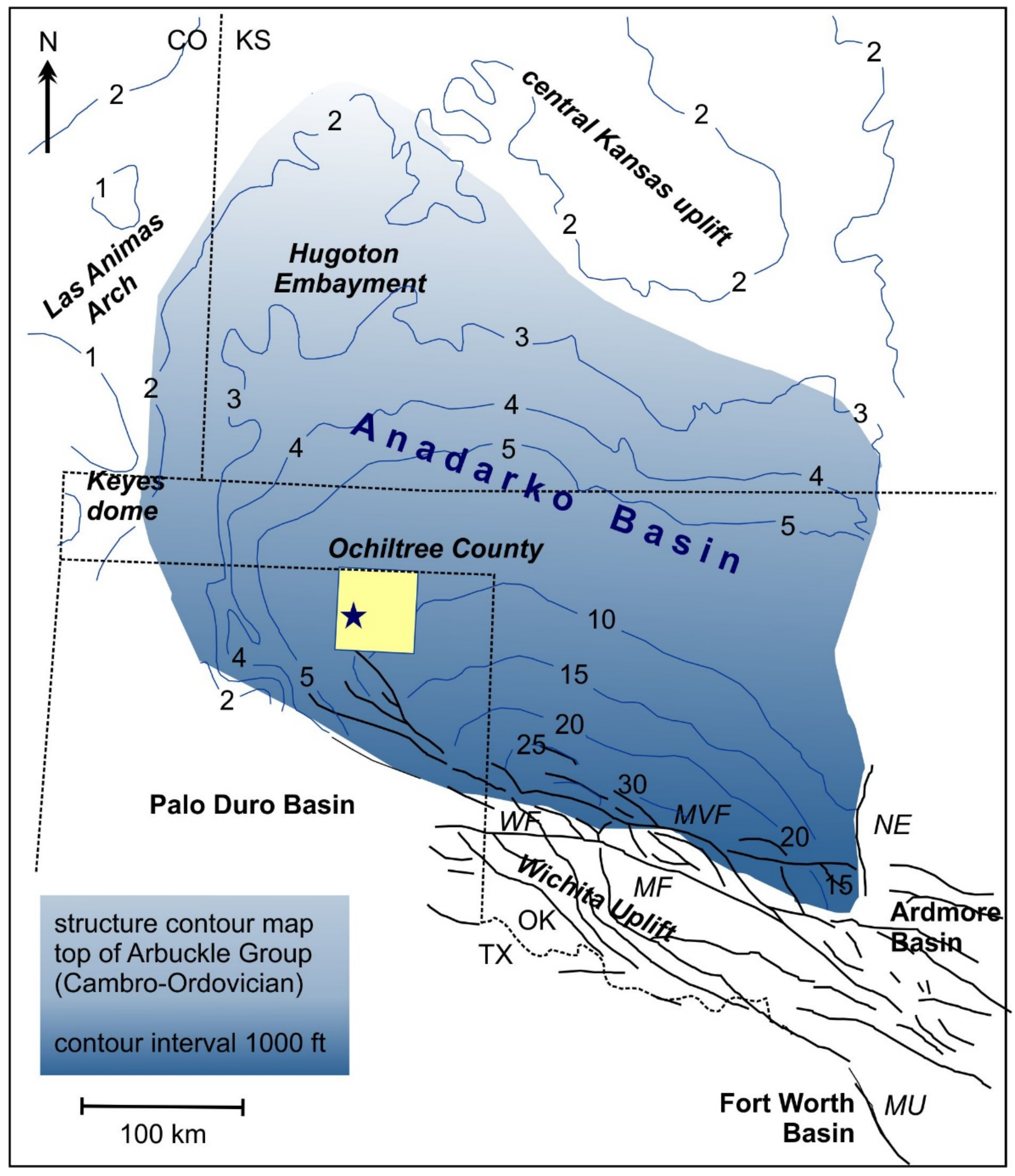

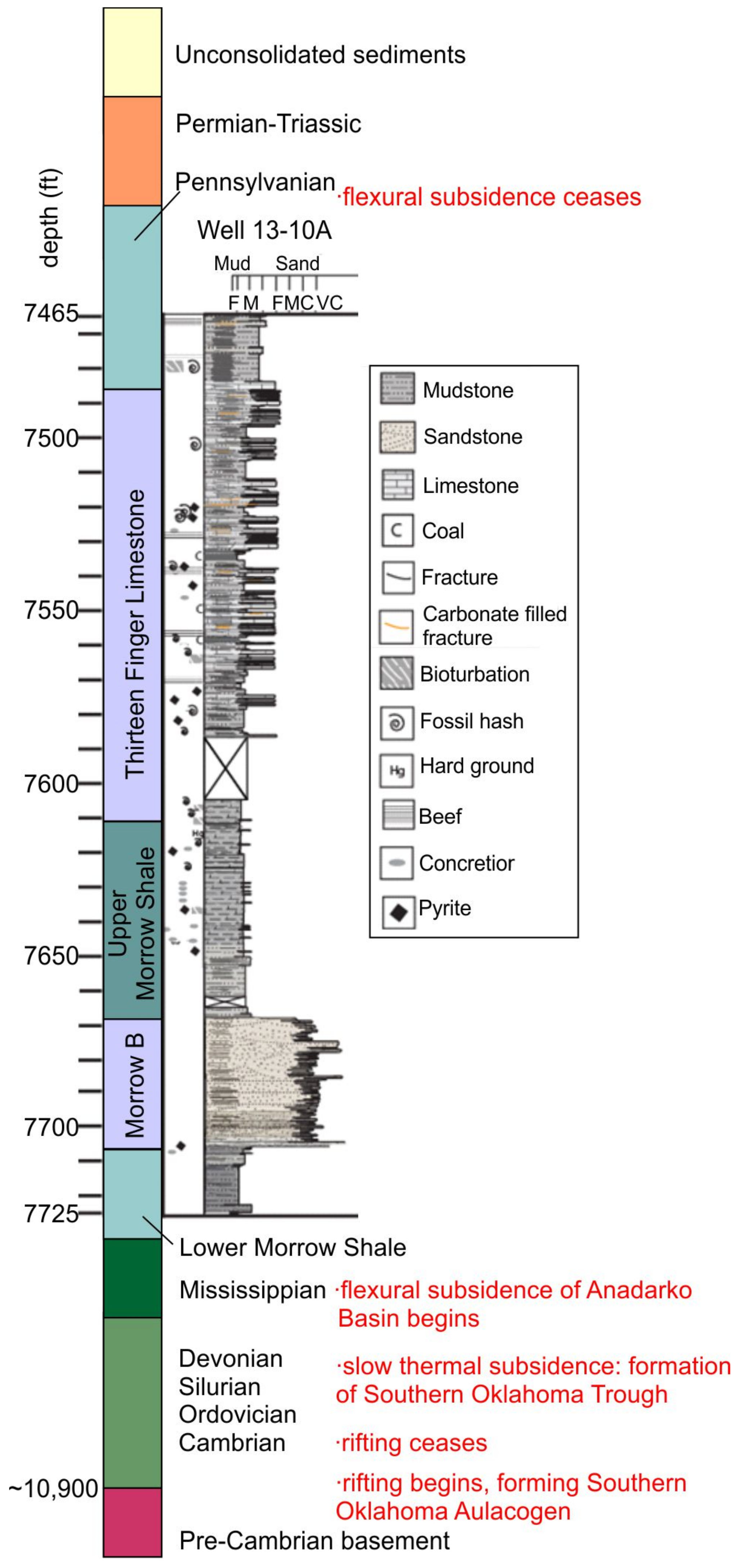
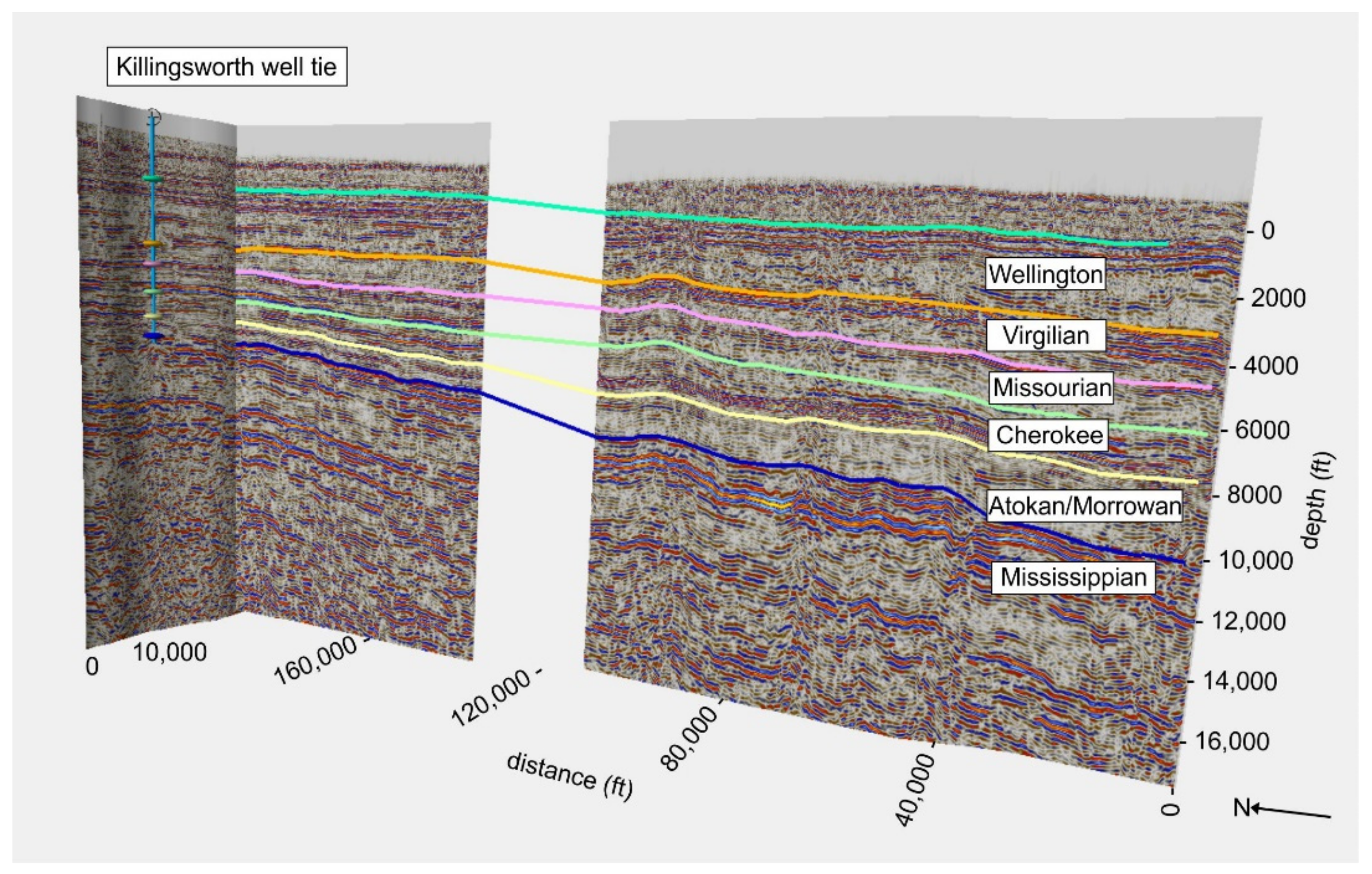
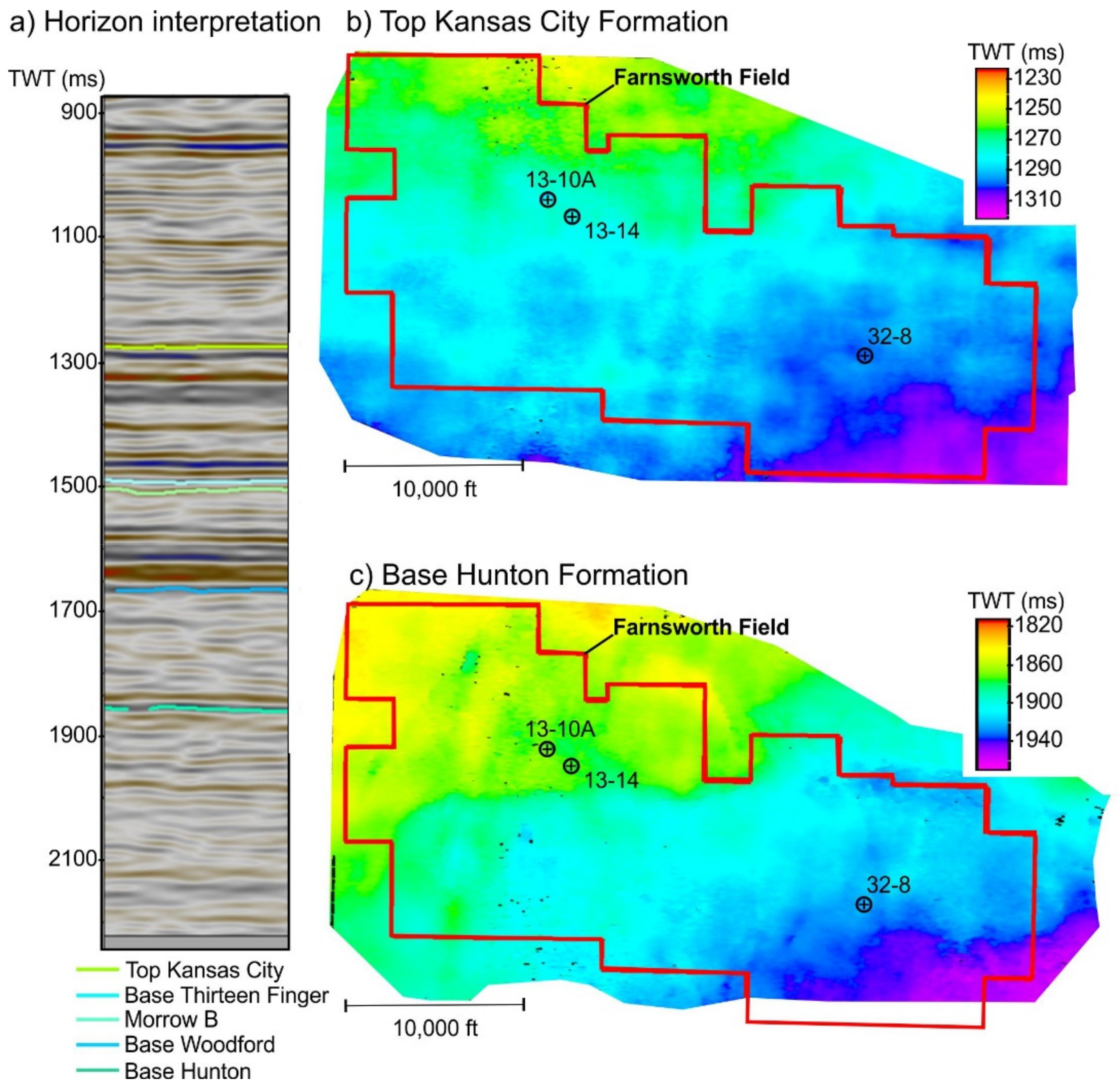
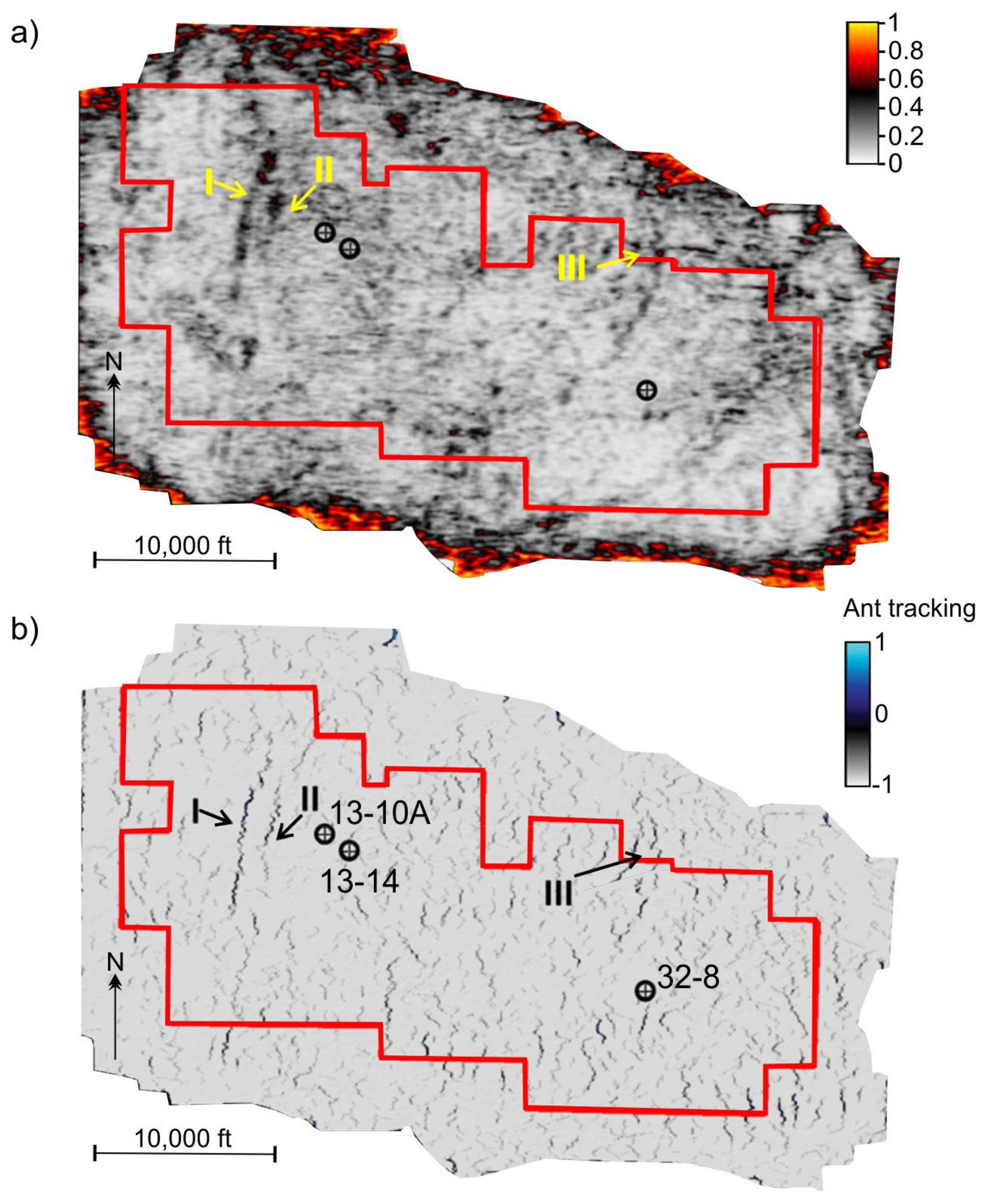

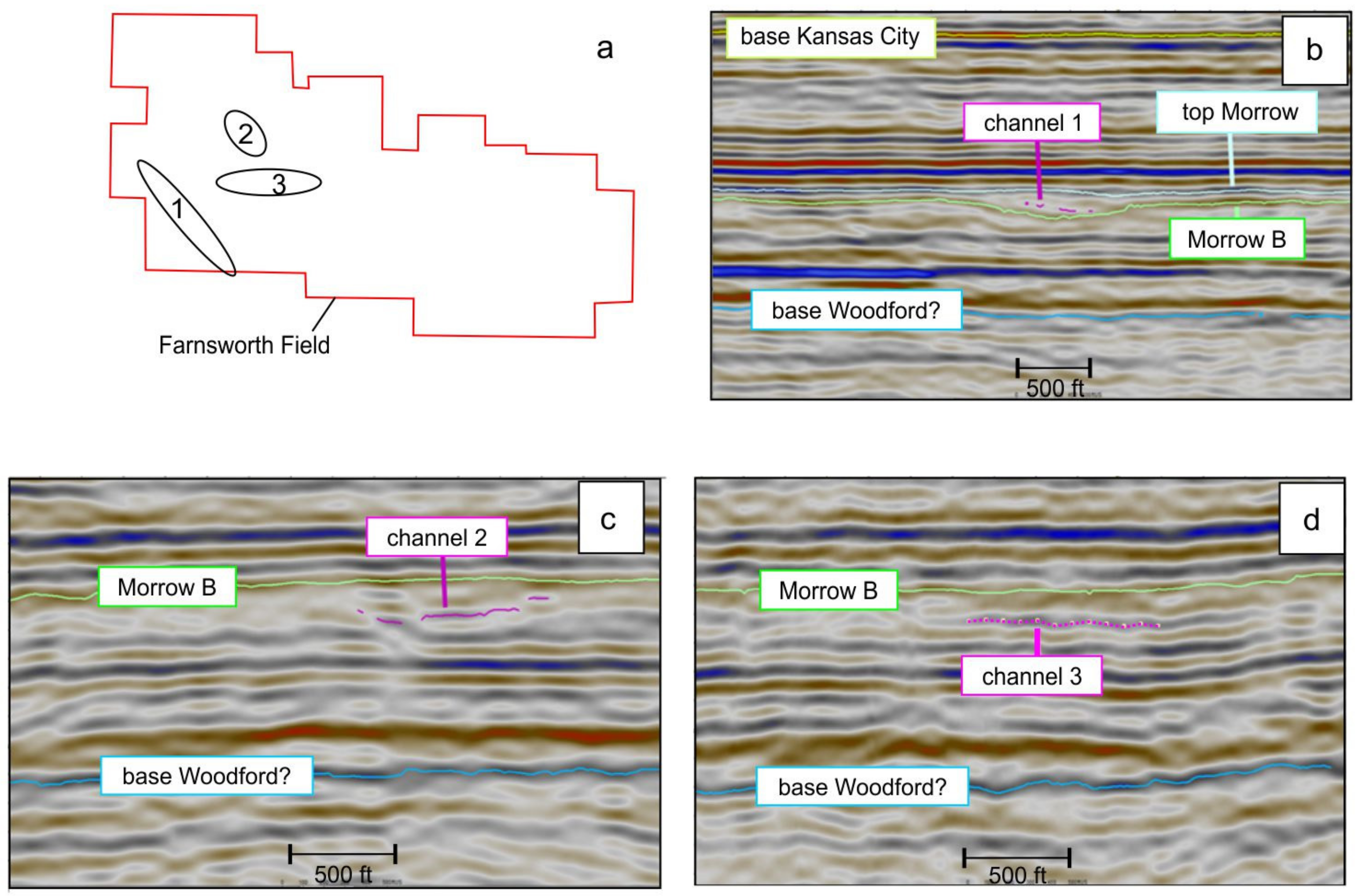
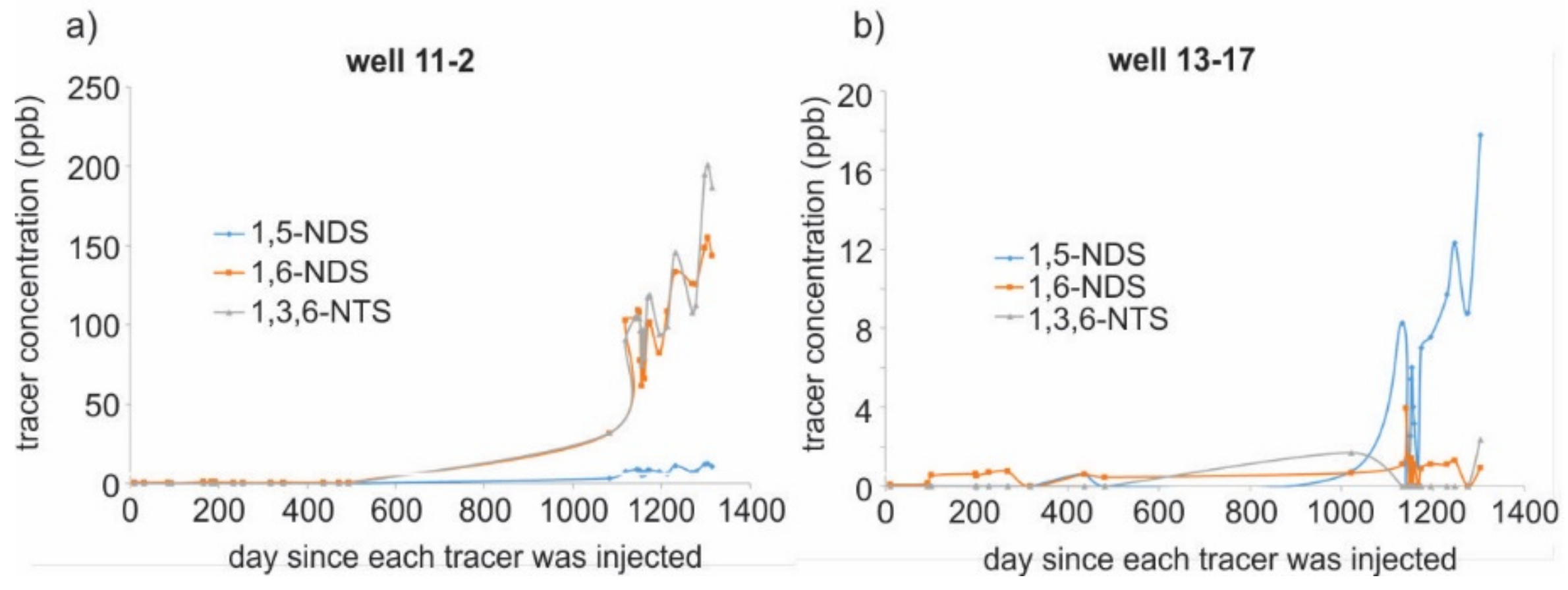

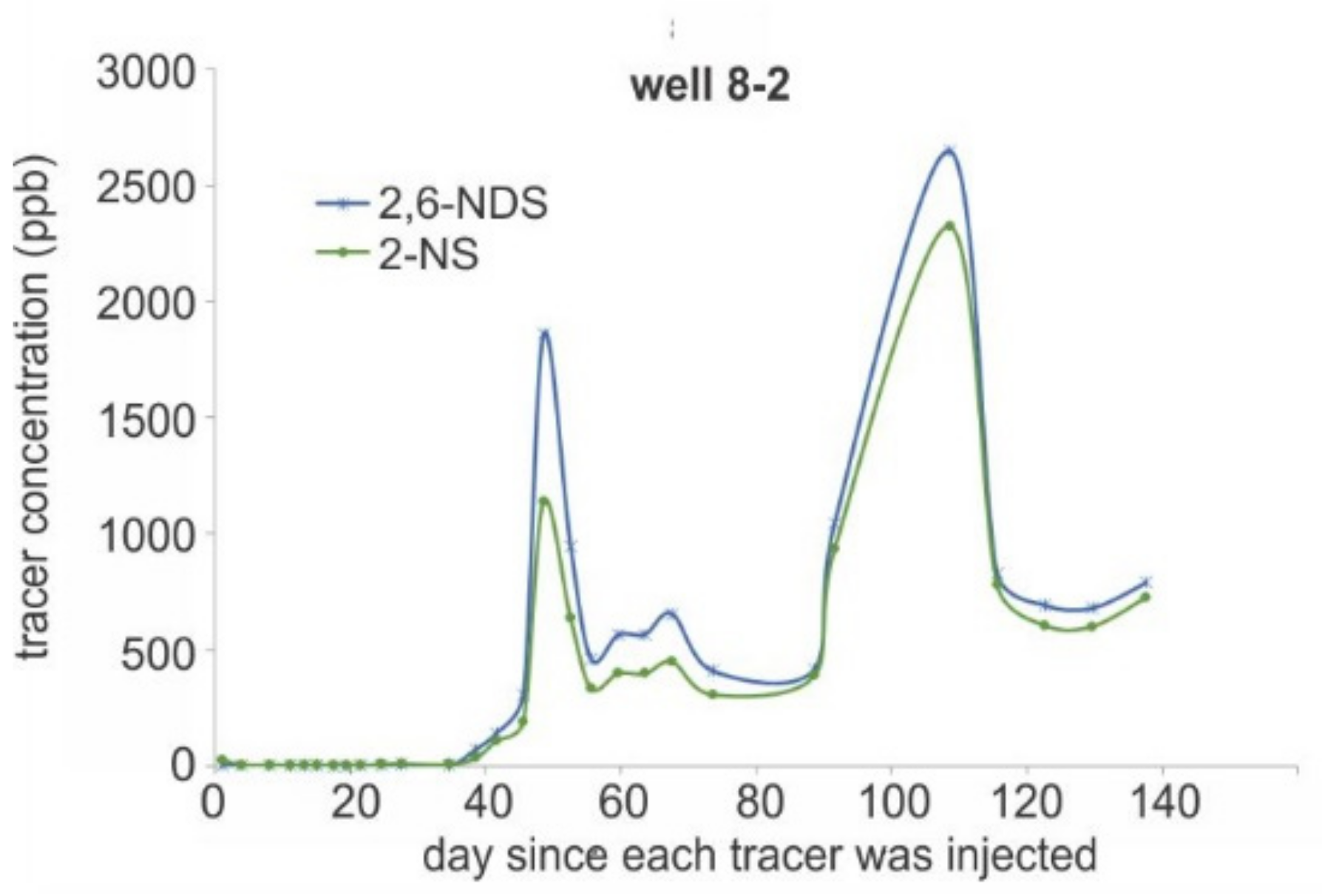
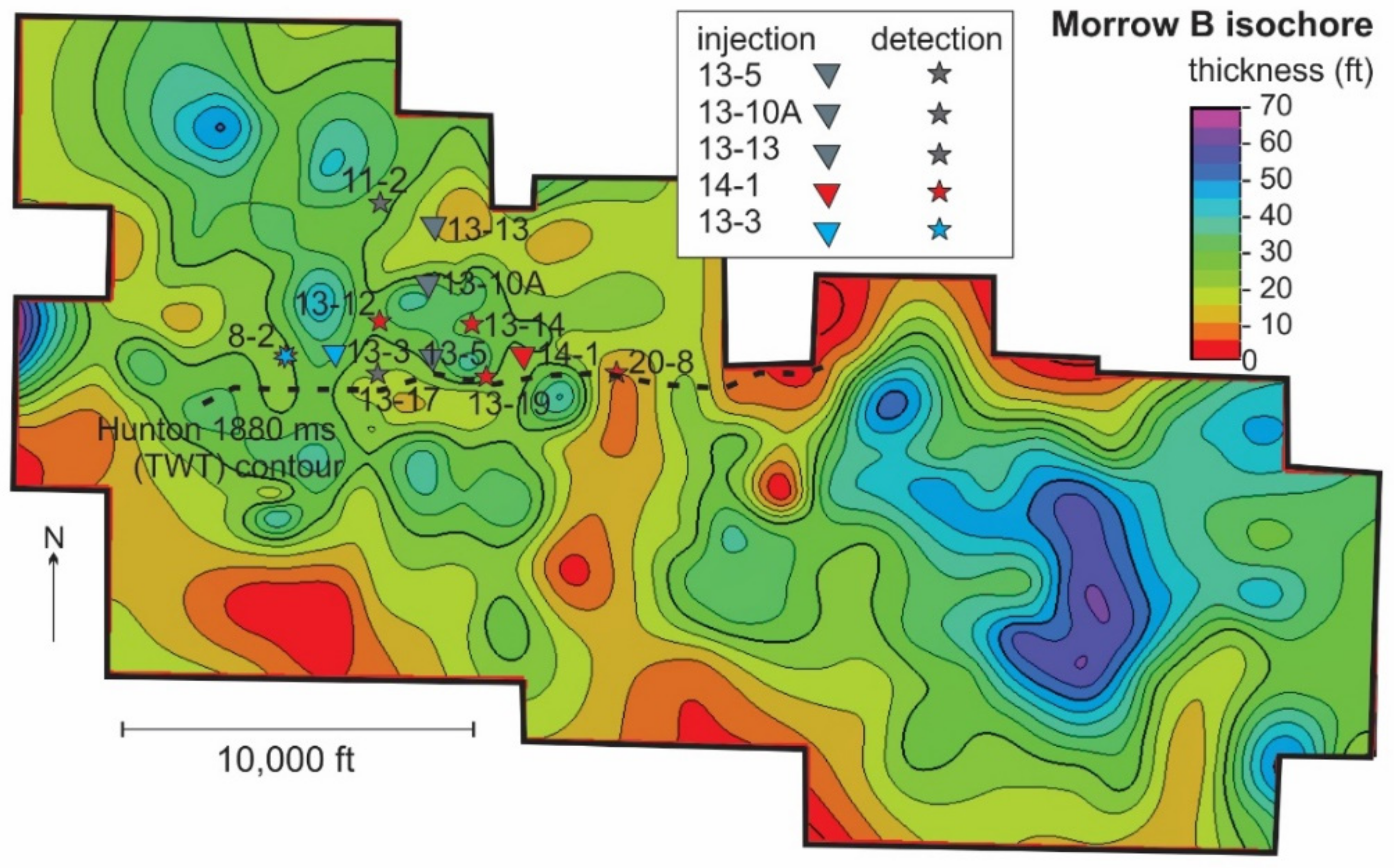
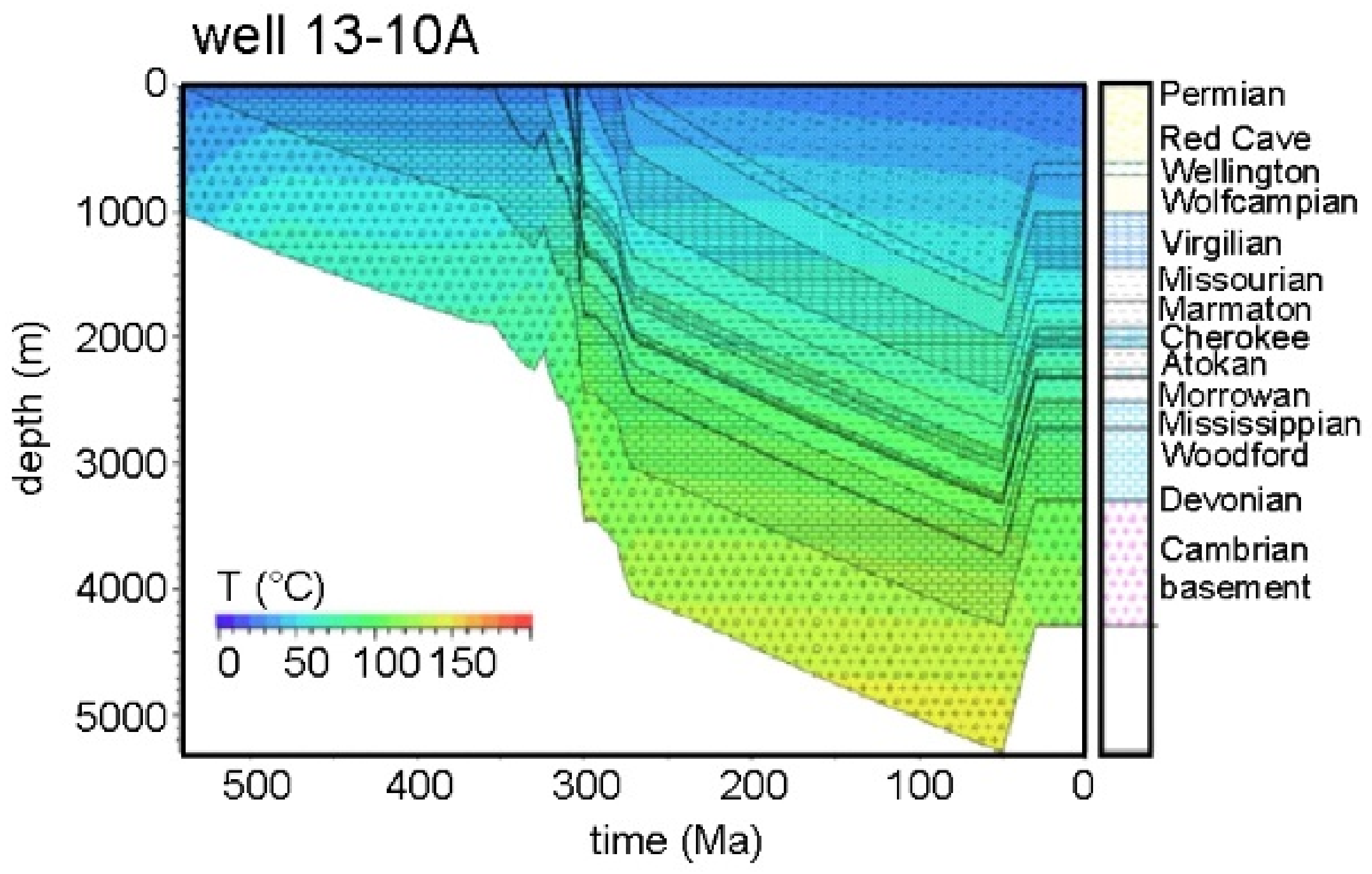

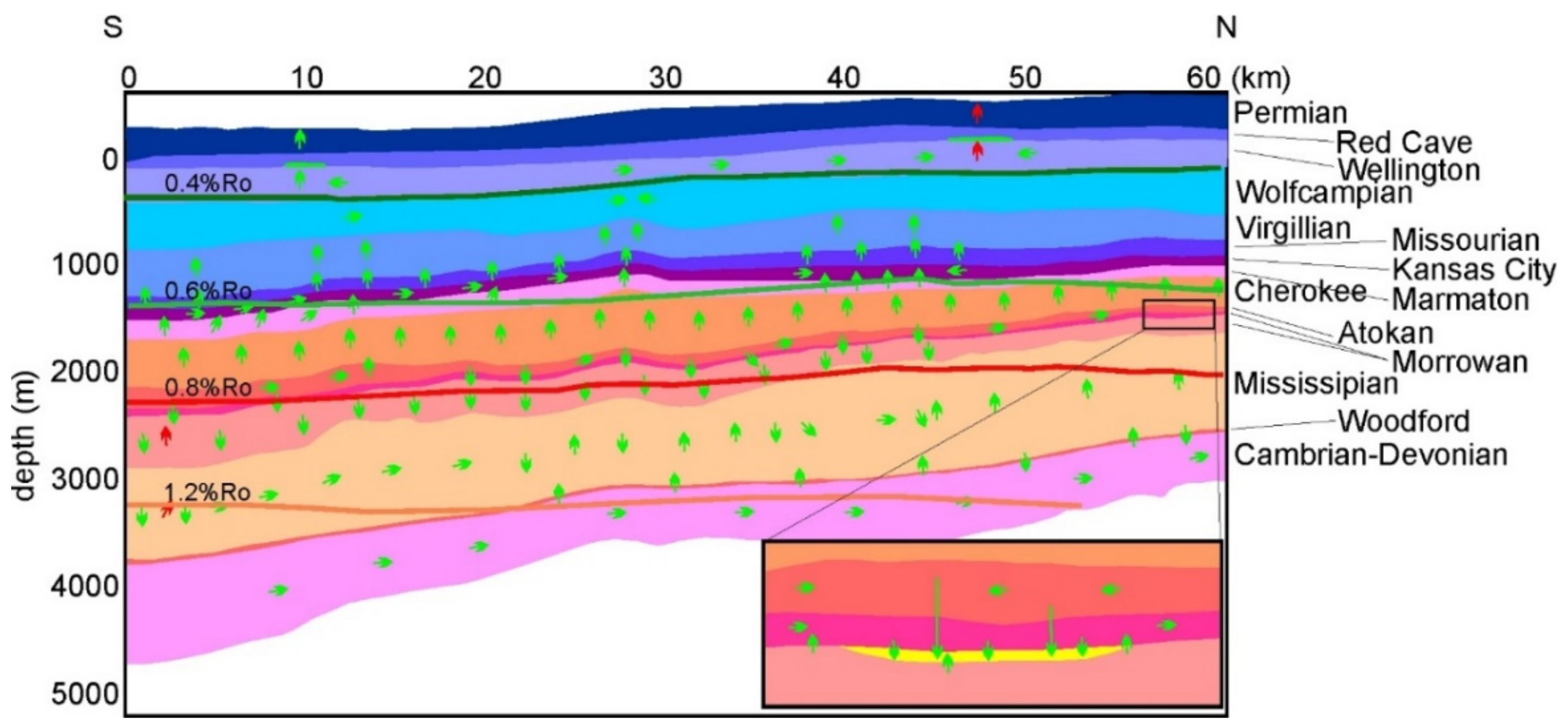
| Tracer | Mass Injected (kg) | Well | Injection Date |
|---|---|---|---|
| 1,6-naphthalene disulfonate (1,6-nds) | 27.5 | 13-13 | 2 May 2014 |
| 1,3,6-naphthalene trisulfonate (1,3,6-nts) | 50 | 13-10A | 2 May 2014 |
| 1,5-naphthalene disulfonate (1,5-nds) | 25 | 13-5 | 2 May 2014 |
| 2,7-naphthalene disulfonate (2,7-nds) | 100 | 14-1 | 13 October 2015 |
| 2,6-naphthalene disulfonate (2,6-nds) | 100 | 13-3 | 15 June 2017 |
| 2-naphthalene sulfonate (2-ns) | 80 | 13-3 | 15 June 2017 |
| Layer Name | Top (m) | Base (m) | Deposited from-to (Ma) | Erosion (Ma) [Amount] | Lithology | HI | TOC | Kinetics |
|---|---|---|---|---|---|---|---|---|
| Permian-Cenozoic | 0 | 600 | 30 | 50–30 Ma [1000 m] | Sandstone (subarkose, clay rich) | - | - | - |
| Red Cave | 600 | 712 | 275–270 | - | Organic lean siltstone | - | - | - |
| Wellington | 712 | 1006 | 280–275 | - | Sandstone | - | - | - |
| Wolfcampian | 1006 | 1472 | 299–280 | - | Dolomite | - | - | - |
| Virgilian | 1472 | 1731 | 303–299 | - | Shale | - | - | - |
| Missourian | 1731 | 1932 | 304–303 | - | Shale | - | - | - |
| Kansas City | 1932 | 2021 | 305–304 | - | Limestone (shaly) | - | - | - |
| Marmaton | 2021 | 2094 | 305.3–305 | - | Limestone (shaly) | - | - | - |
| Cherokee | 2094 | 2279 | 310–305.3 | - | Shale | - | - | - |
| Thirteen Finger | 2279 | 2320 | 311–310 | - | Limestone (shaly) | 355 | 9.18 | [78] TII |
| Upper Morrow shale | 2320 | 2339 | 311–310 | - | Shale (organic rich) | 57 | 3.62 | [78] TII |
| Morrow B | 2339 | 2350 | 314–313.7 | - | Sandstone, subarkose | - | - | - |
| Lower Morrow shale | 2350 | 2533 | 324–314.5 | 314.5–314 [15 m] | Shale (organic rich) | 10 | 1.1 | [78] TIII |
| Mississippian | 2533 | 2745 | 354–330 | 330–324 [150] | Limestone (organic rich) | - | - | - |
| Woodford | 2745 | 2758 | 369–354 | - | Shale (organic rich) | 300 | 1.8 | [79] |
| Cambrian-Devonian | 2758 | 3320 | 542–369 | - | Limestone | - | - | - |
| Basement | 3320 | - | - | - | Granite (>1000 Ma) | - | - | - |
Publisher’s Note: MDPI stays neutral with regard to jurisdictional claims in published maps and institutional affiliations. |
© 2021 by the authors. Licensee MDPI, Basel, Switzerland. This article is an open access article distributed under the terms and conditions of the Creative Commons Attribution (CC BY) license (https://creativecommons.org/licenses/by/4.0/).
Share and Cite
van Wijk, J.; Hobbs, N.; Rose, P.; Mella, M.; Axen, G.; Gragg, E. Analysis of Geologic CO2 Migration Pathways in Farnsworth Field, NW Anadarko Basin. Energies 2021, 14, 7818. https://doi.org/10.3390/en14227818
van Wijk J, Hobbs N, Rose P, Mella M, Axen G, Gragg E. Analysis of Geologic CO2 Migration Pathways in Farnsworth Field, NW Anadarko Basin. Energies. 2021; 14(22):7818. https://doi.org/10.3390/en14227818
Chicago/Turabian Stylevan Wijk, Jolante, Noah Hobbs, Peter Rose, Michael Mella, Gary Axen, and Evan Gragg. 2021. "Analysis of Geologic CO2 Migration Pathways in Farnsworth Field, NW Anadarko Basin" Energies 14, no. 22: 7818. https://doi.org/10.3390/en14227818
APA Stylevan Wijk, J., Hobbs, N., Rose, P., Mella, M., Axen, G., & Gragg, E. (2021). Analysis of Geologic CO2 Migration Pathways in Farnsworth Field, NW Anadarko Basin. Energies, 14(22), 7818. https://doi.org/10.3390/en14227818





